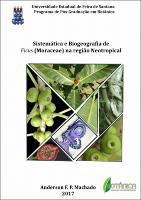| Compartilhamento |


|
Use este identificador para citar ou linkar para este item:
http://tede2.uefs.br:8080/handle/tede/764| Tipo do documento: | Tese |
| Título: | Sistemática e Biogeografia de Ficus (Moraceae) na região Neotropical |
| Autor: | Machado, Anderson Ferreira Pinto  |
| Primeiro orientador: | Queiroz, Luciano Paganucci |
| Resumo: | Ficus L. (Moraceae), com aproximadamente 750 espécies, caracteriza-se por seu tipo de inflorescência, o sicônio ou figo, um receptáculo encerrado por brácteas em uma região denominada ostíolo. Duas linhagens do gênero ocorrem na Região Neotropical, Ficus sect. Americanae (~100 species) e Ficus sect. Pharmacosycea (~20 species). A grande diversificação das figueiras nas florestas úmidas ao redor do globo e a ocorrência de espécies em todos os biomas neotropicais fazem de Ficus um modelo interessante para auxiliar na compreensão dos mecanismos associados à diversificação de espécies na região Neotropical. Este trabalho visou contribuir para a solução de problemas taxonômicos em Ficus sect. Americanae; apontar caracteres potencialmente importantes para a taxonomia do grupo e entender o processo de diversificação das espécies nos Neotrópicos auxiliando na compreensão da história da diversidade nesta região. Para tais fins, utilizou-se a metodologia da taxonomia clássica com análise das obras originais e das coleções tipo, trabalho de campo e estudos morfológicos; abordagem anatomia vegetal bem como análises filogenéticas e biogeográficas. Os resultados aqui apresentados incluem a descrição de duas novas espécies, o estabelecimento de dois nomes novos e o restabelecimento de uma espécie antes considerada sinônimo. Ainda na parte taxonômica é apresentada uma chave para as espécies de Ficus sect. Americanae no Domínio da Mata Atlântica. No que se refere ao estudo de caracteres micromorfológicos aqui é reportada, pela primeira vez, uma especialização das brácteas que encerram o sicônio, bem como dos coléteres nas inflorescências do gênero. A abordagem biogeográfica mostrou que a diversificação das figueiras neotropicais iniciou-se entre o Oligoceno e o Mioceno e que o gênero passou por dois momentos de maior diversificação, no Mioceno Médio e no Plioceno. Nossos resultados também evidenciaram que o hábito hemiepífito e o tamanho reduzido dos propágulos de Ficus sect. Americanae possibilitaram uma maior diversificação desta linhagem nos Neotrópicos se comparada a Ficus sect. Pharmacosycea |
| Abstract: | Ficus L. (Moraceae), with approximately 750 species, is characterized by its typical inflorescence, the syconium or fig, a receptacle enclosed by bracts in a region called ostiole. Two lineages of the genus occur in the Neotropical Region, Ficus sect. Americanae (~ 100 species) and Ficus sect. Pharmacosycea (~ 20 species). The great diversity of the fig trees in the wet forests worldwide and the occurrence of species in all the Neotropical biomes make Ficus an interesting model to study the processes associated with diversification species in the Neotropical region. This work aimed to: contribute to the solution of taxonomic problems in Ficus sect. Americanae; to discover characters potentially relevant in taxonomy; to understand the process of species diversification in the Neotropics, helping to understand the history of diversity in this region. To accomplish to these goals, we use classical taxonomic procedures with analysis of the protologues and type collections, field work, morphological and anatomical studies as well as phylogenetic and biogeographical analyses. The results presented here are taxonomic novelties with the description of two new species, the establishment of two new names and the reestablishment of a species previously considered as a synonym. It is also is presented a key for species of Ficus sect. Americanae in the Mata Atlântica Domain. It is reported for the first time a specialization of the bracts surrounding the ostiole, as well as of the colleters in the inflorescences of the genus. The biogeographic approach showed that the diversification of the Neotropical fig trees began between the Oligocene and the Miocene and that the genus went through two bursts of diversification (in the Middle Miocene and Pliocene). Our results also showed that the hemiepiphyte habit and the reduced size of Ficus sect. Americanae allowed a greater diversification of this lineage in the Neotropics when compared to Ficus sect. Pharmacosycea. |
| Palavras-chave: | Amazônia Biogeografia Ficus sect. Americanae Ficus sect. Pharmacosycea Filogenia Mata Atlântica Amazon Biogeography Ficus sect. Americanae Ficus sect. Pharmacosycea Phylogeny Atlantic Forest |
| Área(s) do CNPq: | BOTANICA::FISIOLOGIA VEGETAL |
| Idioma: | por |
| País: | Brasil |
| Instituição: | Universidade Estadual de Feira de Santana |
| Sigla da instituição: | UEFS |
| Departamento: | DEPARTAMENTO DE CIÊNCIAS BIOLÓGICAS |
| Programa: | Doutorado Acadêmico em Botânica |
| Citação: | MACHADO, Anderson Ferreira Pinto. Sistemática e Biogeografia de Ficus (Moraceae) na região Neotropical. 2017. 128f. Tese (Doutorado Acadêmico em Botânica) - Universidade Estadual de Feira de Santana, Feira de Santana, 2017. |
| Tipo de acesso: | Acesso Aberto |
| URI: | http://tede2.uefs.br:8080/handle/tede/764 |
| Data de defesa: | 27-Jul-2017 |
| Aparece nas coleções: | Coleção UEFS |
Arquivos associados a este item:
| Arquivo | Descrição | Tamanho | Formato | |
|---|---|---|---|---|
| Machado_AFP_Tese_Ficus_PPGBot_UEFS.pdf | Tese_Anderson_2017 | 4,45 MB | Adobe PDF |  Baixar/Abrir Pré-Visualizar |
Os itens no repositório estão protegidos por copyright, com todos os direitos reservados, salvo quando é indicado o contrário.




